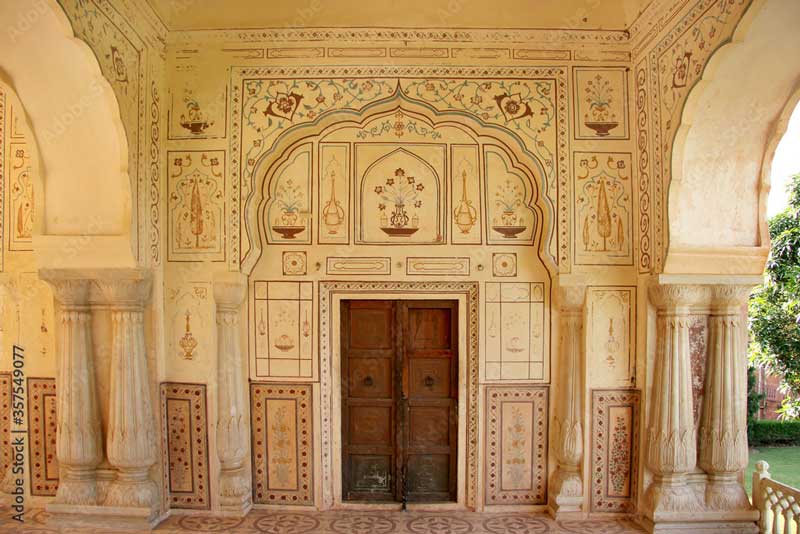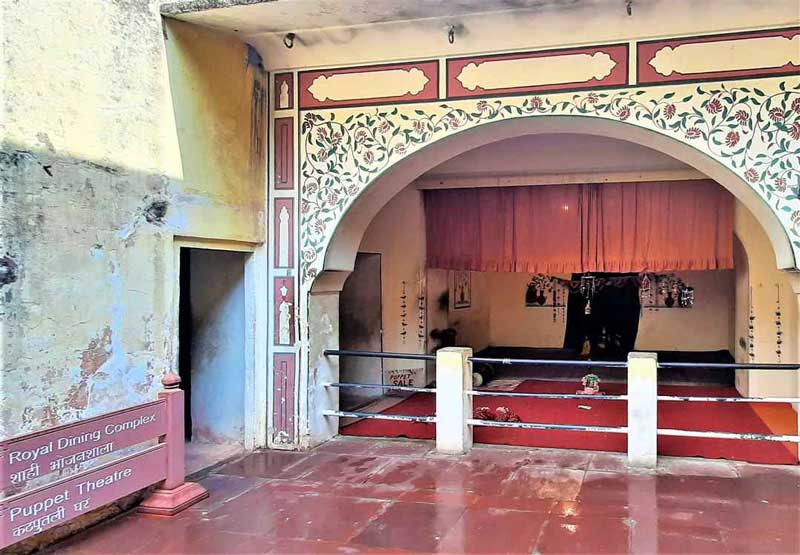
Located about 10 km from Jaipur, atop Cheel ka Teela or Hill of Eagles, one of the peaks of the Aravalli range of hills, towering at an impressive height of 1640 feet (500 m) above sea level and offering an unobstructed view of Amer Fort and the Maota Lake, Jaigarh Fort was built by Sawai Jai Singh in 1726 to protect the Amer Fort, also known as Amber Fort, and the palace within the fort complex. The fort, offering a breathtaking view of the surrounding green hills, rugged and similar in structural design to the Amer Fort, is also known as Victory Fort and is one of the most distinguishing historical monuments in Rajasthan. The fort, basically constructed for the protection of the Amber Fort, is connected to it by subterranean passages and is considered as one complex. With a length of around 3 km along the north-south direction and a width of a km and an elevation of 400 ft from the Amber Fort, it has many unique features, which include a cannon named Jaivana, which was manufactured in the fort precincts and was the world's largest cannon on wheels at that time, but was never used in a battle, as the Rajput rulers of Amer maintained friendly relations with the Mughals. However, it was fired only once for a test, when fired with a charge of 100 kg of gunpowder, it covered a distance of about 35 km.

The history of Amer and Jaigarh is indelibly linked together as they were ruled by the Kachawahas Rajput clan from the early 10th century. During the reign of the Mughal Emperor Shah Jahan, the Jaigarh Fort became their empire's main cannon foundry, mainly due to the abundance of iron ore mines in the neighbouring area and was also used as a stronghold to store ammunition. The cannon foundry at the Jaigarh Fort had a massive wind tunnel that sucked the free air from the high mountains into its furnace, creating a very high temperature, sufficient to melt the metal. The molten metal, deposited in a reservoir chamber, would then pass into a cannon mould in the casting pit. Most of those cannons, prepared within a single day, were massive, mostly 16 feet long. During the Mughal war of succession in 1658, Dara Shiko took hold of the cannon outpost of Jaigarh Fort, until he was defeated and executed by his younger brother Aurangzeb, who eventually took the throne. Ultimately, the fort was handed over to Jai Singh II, who is known to have moulded the great Jaivana Cannon by using the devices of the foundry inside the fort.

Built in Indo-Persian style, the Jaigarh Fort is highly fortified with thick cyclopean walls of red sandstone, spread over a vast range of 3 km in length, with a width of one km and adorned with an impressive garden, surrounded by ramparts which lead to the upper levels of the fort. While the Dungar Darwaza serves as the fort's main entrance, the fort's red and yellow triple arch gateway, with the fortification walls above it, is oriented in an east-west direction and faces west.

The fort complex has a huge parade ground of the Rajput army, containing massive war drums and houses a majestic palace complex, each equipped with courtrooms and halls, decorated with screened windows. The Laxmi Vilas, the royal drawing room of the King, embellished with pleasant wall paintings and excellent flooring, was an area for important meetings and royal relaxation, while the Lalit Mandir was the summer palace of the King at the fort. There is a small theatre area on the ground floor, which once served as a royal entertainment area for music and drama, now used as a Puppet Theatre to the delight of the visitors. The Vilas Mandir was the Zenana Mahal or the area for the ladies, equipped with lattice windows and jharokhas, offering the view of the entire fort. In addition to that, the complex also contains the assembly hall of the warriors known as Shubhat Niwas, a museum and an armoury

The armoury chamber of the fort houses several swords, shields, guns and muskets, along with a massive 50 kg cannonball. The walls of the chamber also display the old photographs of Maharaja Sawai Bhawani Singh and Major General Man Singh II, who served as senior officers in the Indian Army. The museum, located to the left of the Awami Gate, displays photographs of the Royalty of Jaipur, stamps and several artefacts, including a circular pack of cards, a spittoon of the 15th century and a hand drawn plan of the palaces located in the fort complex.

Apart from the palaces, the fort complex also contains two temples, the Ram Harihar Temple of the 10th century and the Kaal Bhairav Temple of the 12th century. There is also a central watch tower, constructed on a raised ground, which provides excellent vistas of the surrounding landscape.

The supply of water in the fort was met by creating water harvesting structures in the neighbouring area and channelling it through a canal for around 4 km to the west side of the fort, to be stored in three underground tanks constructed below the central courtyard of the fort, the largest of which had a capacity of 6 million gallons of water. There was a strong rumour that a huge treasure belonging to the Kachwaha Rajput rulers of Amer had been stacked and hidden in the fort area, which could be in some secret chambers, constructed below the water tanks. Influenced by the rumour, a raid was organized in 1977, during the emergency declared by the then Prime Minister of India, Mrs Indira Gandhi and despite the strong objection of Maharani Gayatri Devi, army troops were sent to the fort to recover the treasure. But the search of all the buildings in the fort for around six months, from 10 June 1976 till November 1976, by the Income Tax department, using metal detectors, ended unsuccessfully.
